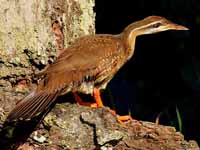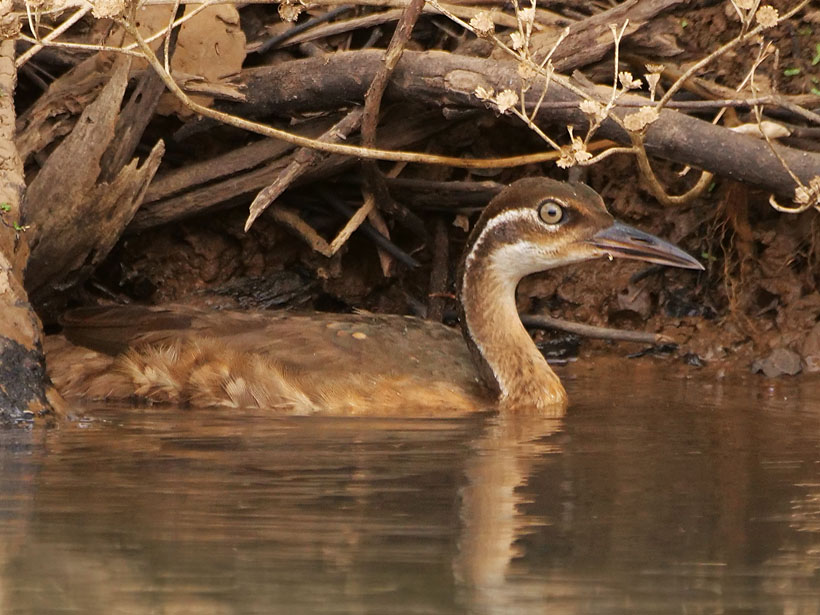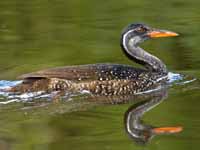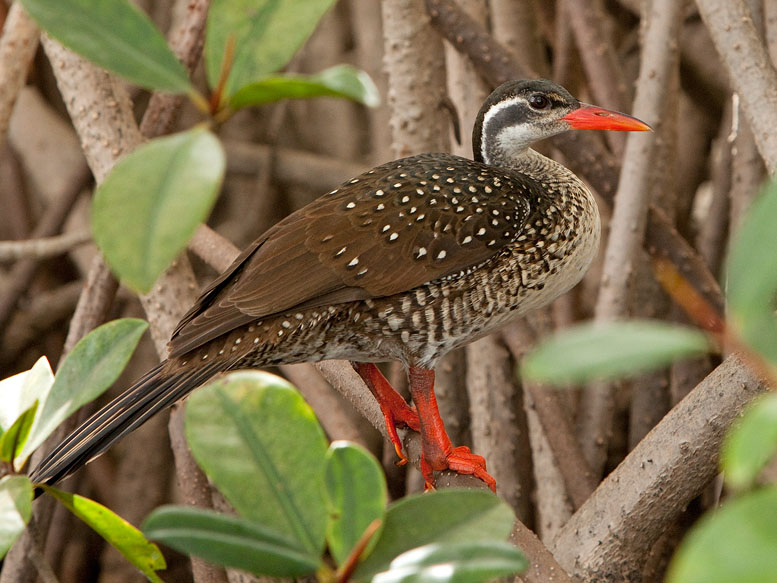THE WORLD BIRDS - An Online Bird Book
GRUIFORMES
GRUIFORMES
Gruiformes means "crane-like", The order include 14 species of large cranes, about 145 species of smaller crakes and rails, as well as a variety of families comprising a small number of species.
Guiformes has the following families
Guiformes has the following families
The Heliornithidae are a small family of aquatic birds with webbed lobes on their feet like those of grebes and coots. Finfoots resemble rails; they have long necks, broad tails, and sharp, pointed bills. Their legs and feet are brightly colored and, unlike grebes, they are capable of walking well and even moving quickly on land. They have a diverse range of calls, but do not call frequently.
There are 3 finfoot species and they are found in widely separated areas: the New World, Africa, and Asia. Inspite of their distant locations, they are fairly similar in appearance: finned feet, long and pointed bills with the same general shape, and a white line on the head that emenates from behind the eye.
They are shy and difficult to observe. Finfoots are rarely seen in open water or on land without undergrowth. They are found near rivers, streams, and lakes with good cover on the banks. They eat aquatic insects, crustaceans, snails, frogs, fish. Finfoots will forage on banks of waterbodies as well as in them.
Genus Heliornis - 1 species
Finfoot, American Heliornis fulica
Description: The American finfoot, also known as the sungrebe, has brown upperparts. It has a black crown, extended white supercilium, and a black nape. The female has a rufous patch on her face. On the male that face patch is replaced with white. There is a black stripe down the side of the neck, bordered on the rear by a white stripe, and on the other side by the white throat. The underparts are whitish. It has lobed toes banded with dull yellow and black. The sungrebe is up to 33 cm long. The "grebe" in its name indicated the resemblance to a grebe, but they are not in the same family or closely related.
Both parents build a nest of twigs and reeds that overhangs the water, about a meter above it. They also both incubate the eggs. The male is the main caregiver of the chicks. In fact he has a shallow pocket under his wing that can hold up to two chicks when he is swimming on even while flying.
Range: Mexico to much of South America.
Habitat: Well-covered slow-flowing streams and secluded waterways.
Diet: Aquatic and terrestrial insects and other arthropods, snails, frogs, lizards.
Conservation status: Least Concern.
Image by: 1) Allan Hopkins - Guyana 2) Muchaxo 3) Dave Curtis - Guyana 4) P Witt - Coasta RicaBoth parents build a nest of twigs and reeds that overhangs the water, about a meter above it. They also both incubate the eggs. The male is the main caregiver of the chicks. In fact he has a shallow pocket under his wing that can hold up to two chicks when he is swimming on even while flying.
Range: Mexico to much of South America.
Habitat: Well-covered slow-flowing streams and secluded waterways.
Diet: Aquatic and terrestrial insects and other arthropods, snails, frogs, lizards.
Conservation status: Least Concern.
1, 2) Female 3, 4) Male

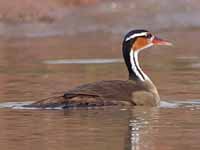
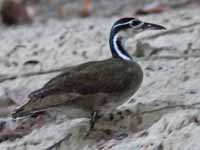
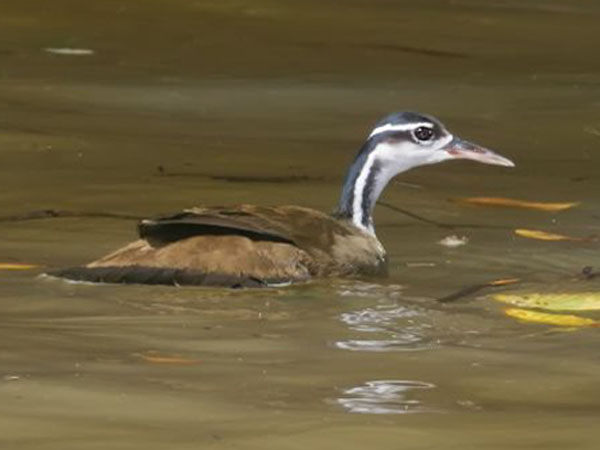
Genus Heliopais - 1 species
Finfoot,_Masked Heliopais personatus
Description: The masked finfoot has brown upperparts including the wings and tail. The male has a black forehead, fore-crown, mask, chin and throat. The female has a black mask and curved eye-line; a white chin and white throat. They both have a grey nape and pale underparts plus green lobed feet. In breeding season, the male has a knob above the base of the bill. The masked finfoot is up to to 55 cm long.
Range: Indian subcontinent, Indochina, Indonesia, Malaysia.
Habitat: Swamps, sheltered ponds and streams, flooded forest, mangrove swamps.
Diet: Aquatic insects, crustaceans, snails, frogs, fish. They will forage on banks of waterbodies as well as in them.
Conservation status: It is listed as Endangered with less than 500.
Image by: 1) Tunpin.ong - Kuala Lumpur 2) Touhid_BiplobRange: Indian subcontinent, Indochina, Indonesia, Malaysia.
Habitat: Swamps, sheltered ponds and streams, flooded forest, mangrove swamps.
Diet: Aquatic insects, crustaceans, snails, frogs, fish. They will forage on banks of waterbodies as well as in them.
Conservation status: It is listed as Endangered with less than 500.
1) Female 2) Male
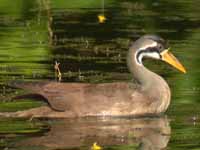

Genus Podica - 1 species
Finfoot, African Podica senegalensis
Description: The African finfoot is an underwater specialist with a long neck, a striking sharp bill, and bright red, lobed feet. The plumage varies by race, generally pale underparts and darker on the upperparts. The males are usually darker than the females. The African finfoot is up to 59 cm long.
Range: Sub-Saharan Africa.
Habitat: Rivers, streams, and lakes with good cover on the banks.
Diet: Aquatic insects, crustaceans, snails, frogs, fish. They will forage on banks of waterbodies as well as in them..
Conservation status: Least Concern.
Image by: 1) Sias van Schalkwyk - South Africa 2) Nik Borrow - Senegal 3) Gip Gipukan 4) Paul Cools - GambiaRange: Sub-Saharan Africa.
Habitat: Rivers, streams, and lakes with good cover on the banks.
Diet: Aquatic insects, crustaceans, snails, frogs, fish. They will forage on banks of waterbodies as well as in them..
Conservation status: Least Concern.
